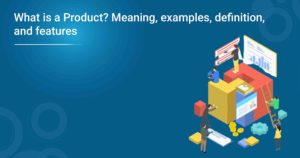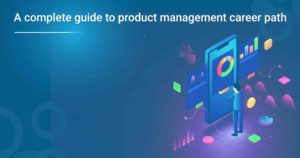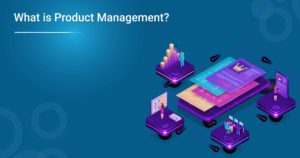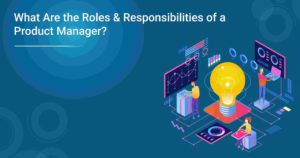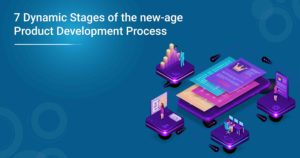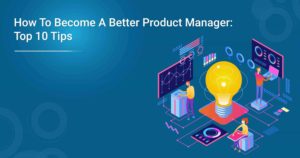In today’s fast-paced and ever-changing business environment, companies must continually innovate and bring new products to market to stay competitive. The product development process has evolved to keep up with the demands of businesses and consumers.
Gone are the days of creating a one-dimensional product development process. To develop successful new products, businesses need to embrace a more dynamic and fluid approach. There are now 7 dynamic stages of the new product development process that companies can use to make groundbreaking products that meet the needs of their customers.
The introduction of new-age products has significantly impacted the way businesses operate. In today’s market, companies need to adapt and alter with the times to stay ahead of the competition. New-age product development allows businesses to do just that.
By definition, new-age product development creates and launches new products or services that are innovative and cutting-edge. This development can help businesses tap into new markets and reach new customers. Additionally, it can help businesses improve their existing products and services to better meet their customers’ needs.
Many benefits come with new-age product development. One of the unavoidable benefits is that it helps businesses stay relevant in an ever-changing marketplace. With new products and services comes new technology, which can help companies to keep up with the latest trends and remain competitive. Additionally, new-age product development helps businesses boost their bottom line by increasing sales and generating new revenue streams.
If your business is looking to stay ahead of the curve, investing in new-age product development is wise. By doing so, you’ll be able to better meet your customers’ needs and remain relevant in an ever-changing marketplace.
In this blog post, we will discuss each stage of the product development process and how it can help your business succeed!
What Is New Product Development and Why Does It Matter?
New product development is the process of creating and bringing new products to market. It includes ideation, research and development, manufacturing, marketing, and sales.
Product development is essential for all businesses because it allows them to bring new products to market that can generate revenue and grow their market value. A successful new product development process can help companies to stay ahead of the competition, keep up with changing customer demands, and increase profits. Additionally, it helps businesses keep up with the competition and meet the needs of their customers.
Want to learn how you can formulate a customised product development process? Go through our Advanced Executive Certificate in Product Management which teaches you everything about product management in a comprehensive manner.
What Are The Stages of the New Age Product Development Process?
Stages of new product development define the process that organisations follow to develop new products. It is a systematic and sequential approach that helps bring new products to the market.

Stage 1: Idea Generation
The first stage of the new product development process is idea generation. In this stage, organisations identify and assess opportunities for new products. It is the phase where you optimise. Market research, brainstorming sessions, customer feedback, etc., can help you get through
Hundreds and thousands of ideas sprout in a business every day, but not every idea is worth pursuing. So, it is essential to have a system in place to filter out the bad thoughts and focus on the good ones.
Also Read: How To Become A Better Product Manager: Top 10 Tips
What Are The Different Sources Of Ideas?
Some of the familiar sources of ideas are:
- Brainstorming sessions
- Customer feedback
- Market research
- Competitor analysis
All the sources of ideas are broadly categorised into internal and external sources. Internal sources are those that are within the organisation, such as employees, customers, etc. External sources are outside the organisation, such as suppliers, industry experts, etc. It is essential to optimally utilise all the sources of ideas to ensure that the best ideas are pursued.
Stage 2: Idea Screening
Once the organisation has generated a list of ideas, the next step is to screen these ideas. The primary reason behind conducting screening is to identify and select the best ideas for further development.
Many criteria can be used for screening the ideas. Some of these criteria may include:
- The potential market for the product
- The technical feasibility of the product
- The manufacturing costs of the product
- The organisational resources required to develop and commercialise the product.
Idea screening is essential in new product development because it helps identify the best ideas and enables the company to steer its resources towards them. For example, if an organisation has limited resources, it may want to focus its resources on the ideas that have the most significant potential for success.
The idea screening stage can be divided into two sub-stages:
- Initial screening
- Detailed screening
During the initial screening stage, the organisation will quickly screen the ideas to identify the best ideas for further development. This stage is often conducted by a small team of people who know the product and the market.
During the detailed screening stage, the organisation will conduct a more in-depth evaluation of the ideas. This stage is often performed by a larger team that includes experts from different functions, such as marketing, engineering, and manufacturing.
After the ideas have been screened, the organisation will select the most appropriate ideas that will go through further stages of product development. The ideas that are not set will be dropped from further consideration.
Stage 3: Concept Development and Testing
The next stage in the new product development process is concept development and testing. In this stage, the organisation develops a detailed description of the product idea and tests it with potential customers.
Concept development involves creating a detailed description of the product idea, including its features and benefits. This stage allows organisations to understand whether the product idea is clear and concise and meets the requirements of the target market.
Once the concept has been developed, it is tested with potential customers. This allows the organisation to gather feedback about the product idea and make necessary changes.
There are four steps involved in concept testing:
Developing the Concept: The first step is to formulate a detailed description of the product idea. This includes identifying the features and benefits of the product. The goal is to ensure that the concept is clear and concise.
Identifying the Target Market: The next step is identifying the product’s target market. This includes identifying the needs and wants of the target market.
Creating a Prototype: The third step is to develop a prototype of the product. This allows potential customers to test and give feedback about the product idea.
Conducting Market Research: The final step is to conduct market research. This includes gathering data about the target market and the competition. Such information is used to make necessary changes to the product concept.
Concept testing has several benefits, including:
- Allowing organisations to gather feedback about the product idea from potential customers.
- Enabling organisations to make necessary changes to the product concept.
- Helping organisations to understand the needs of the target market better.
- Allowing organisations to create a product that is more likely to be successful in the market.
Stage 4: Business Analysis And Marketing Strategy
After the product requirements have been gathered and analysed, it’s time to develop a business analysis and marketing strategy. This stage is about understanding the potential customers for the product, their needs and wants, and how best to reach them. The goal is to create a detailed plan for marketing and selling the new product.
Some of the critical elements of solid business analysis and market strategy include:
- Detailed customer research
- Competitor analysis
- Sales and marketing plans
- Pricing strategy
- Distribution strategy
How To Create A Marketing Strategy?
A good marketing strategy should be based on a thorough understanding of your target market. You need to know your potential customers, their concerns, and the ideal way to approach them. You can conduct customer research, competitor analysis, and market analysis to gather this information.
After getting acquainted with the target market, you can start developing a marketing plan. This plan should include your sales and marketing goals, budget, and strategies for reaching your target market.
The marketing strategy typically evolves with time and as you learn more about your customers and the marketplace. Make sure to regularly update your approach to remain relevant and practical.
Also Read: What Are The Stages And Examples Of A Product Lifecycle?
How To Dodge The Challenges in Marketing Strategy For Product Success?
The challenges in marketing strategy come down to three main things: customer analysis, target markets, and product development. Take a look at these challenges and how you can overcome them.

Customer Analysis: One of the biggest challenges in marketing is understanding your target market. You need to know your potential customers, their needs, and how to reach them. You can conduct customer research, competitor analysis, and market analysis to gather this information.
Target Markets: Another challenge is finding your product’s target market. You need to identify a group of potential customers who are interested in your product and willing to buy it. You can conduct customer research and market analysis to find the right target market.
Product Development: The last challenge is developing a product that meets the needs of your target market. You need to create a valuable and appealing product for your target customers. To do this, you must understand their needs and wants and design a product that meets those needs.
By understanding these challenges and how to overcome them, you can develop a proactive marketing strategy for your product.
Stage 5: Product Development
After the initial research and planning stages, it’s time to start developing your product. The product development stage can be divided into design and prototyping. This is where you’ll take all of your ideas and turn them into a reality.
Designing is all about concentrating on the look, objective, and feel of your product. This includes everything from the overall aesthetics to the user interface. You will need to consider how your product will be used and who your target audience is. The design should be based on how users are going to use the product and what would be its target audience.
A successful product design is a result of effective research and planning. Creating prototypes and testing them with people belonging to the target audience is crucial. It helps in getting feedback about the product and refining it accordingly. Once you have a clear vision for your product, it’s time to start creating prototypes.
Prototyping is an indispensable part of the product development process. It allows you to test your ideas and get feedback from potential users. It’s important to create several prototypes and test them with different people. This will help you refine your product and ensure it meets your target audience’s needs.
Creating a successful prototype requires careful planning and execution. These are a few tips to help you create a successful prototype:
- Keep it simple: A prototype should be designed to test a specific idea or feature. It is not necessary that your prototype must be perfect; it should just be able to communicate your vision.
- Make it robust: A prototype should be able to withstand being used and abused. It must be persistent enough to withstand regular use.
- Get feedback early and often: Feedback is essential for refining a prototype. Make sure you get feedback from potential users as early as possible in the process.
Creating a successful prototype is essential for successful product development. With these tips, you can ensure your prototype effectively communicates your ideas and meet the needs of your target audience.
Stage 6: Product Deployment
After the product has been developed and tested, it’s time to deploy it. This stage involves putting the product into production and making it available to customers. Deploying a new product requires a lot of work; these are a few factors to ponder over:
Manufacturing: The first step is to find a manufacturing partner who can produce your product at scale. You must consider factors like cost, quality, and lead time.
Distribution: Once the product is manufactured, you’ll need to get it into the hands of your customers. This involves developing a distribution strategy and finding partners who can help you reach your target market.
Marketing: Before you can sell your product, you need to let people know it exists. This involves creating a marketing plan and promoting your product through various channels.
Deploying a new product can be challenging, but careful planning and execution will help ensure its success. By considering these factors, you can develop a strategy for putting your product into the hands of your customers.
Stage 7: Commercialisation
The final stage of the product development process is commercialisation. This is where you take your product to market and start selling it to customers. Here are the things to consider when commercialising a new product:
Pricing: You’ll need to develop a pricing strategy that meets the needs of your target market.
Sales: Once you have a pricing strategy in place, you’ll need to start selling your product. This entails developing a sales strategy and finding partners who can help you reach your target market.
Marketing: To sell your product, you need to let people know it exists. This involves creating a marketing plan and promoting your product through various channels.
Benefits of New-Age Product Development

Cost Efficient
Developing and bringing a new product to market can be prohibitively expensive for many companies, especially small businesses. Fortunately, new-age product development methods are often much more efficient and cost-effective than traditional methods.
One of the biggest benefits of using new-age product development methods is that they are often much cheaper than traditional methods. It is because new-age methods often use modern technologies and automation, which can dramatically reduce the time and resources required to develop a new product.
Companies can adapt their products more easily to changing market needs and demands. In addition, new-age product development methods are often much more flexible than traditional methods. As a result, companies using new-age methods can bring forward the products into the market faster and more efficiently, saving them time and money.
Innovation
Innovation has always been a key driver of economic growth. In the past, companies could rely on incremental improvements to existing products and processes to maintain a competitive edge. But in today’s global economy, firms must be able to continually generate new ideas and bring them to market quickly to stay ahead of the competition.
Fortunately, new-age product development methods are geared toward facilitating innovation. These approaches focus on creating an environment conducive to quickly generating new ideas and bringing them to fruition. Additionally, they emphasize collaboration among team members and with other stakeholders, which helps to ensure that all voices are heard and that the best ideas are brought to the fore.
Companies can position themselves for success in today’s highly competitive marketplace by adopting new-age product development methods.
Idea Generation
Innovation has always been critical to businesses, but it’s more important than ever in today’s rapidly changing marketplace. New-age product development helps companies be more agile and responsive to change and provides many benefits that can help organizations stay ahead of the competition. One of the essential benefits of new-age product development is idea generation.
With new-age product development, businesses have access to a wider range of tools and methodologies to help them generate innovative ideas. From design thinking to open innovation, several approaches can be used to spark creativity and come up with game-changing ideas. In addition, new-age product development also provides opportunities for companies to get feedback from customers and other stakeholders early in the process, which can help refine and improve ideas.
By harnessing the power of new-age product development, companies can stay ahead of the competition and keep their finger on the pulse of what’s happening in their industries. By generating innovative ideas regularly, businesses can ensure that they are always bringing new products and services to market that meet the needs of their customers.
Also Read: Theory Of Product Pricing and Costing: Meaning, Fundamentals & Frameworks
Concept Testing
Concept testing is an integral part of new-age product development. By testing potential products and ideas with target audiences, companies can gain valuable insights into whether or not a product is likely to be successful. This type of testing can help to improve the chances of success for new products and can save businesses valuable time and money by avoiding costly mistakes.
Concept testing can take many forms but typically involves presenting potential customers with prototypes or mockups of new products and asking for feedback. This feedback can be used to make changes to the product before it goes to market, ensuring that it is more likely to meet the needs and wants of consumers.
You can avail several benefits by conducting concept testing, including the following:
- Allowing companies to gauge consumer interest in a new product
- Providing insight into what features or benefits consumers value most
- Helping to identify any potential problems with a new product before it goes to market
- Saving businesses time and money by avoiding costly mistakes
Conducting concept testing is an integral part of developing successful new products. By testing potential products with target audiences, companies can gain invaluable insights that can help them create better products that are more likely to succeed.
Polished Marketing Strategy
As the world progresses and technology advances, so do the way that companies market their products. To stay ahead in the challenging marketplace, businesses must update their marketing strategies continuously. New-age product development considers this and provides a polished marketing strategy as a benefit.
Some of the advantages of having a polished marketing strategy as a result of new-age product development include the following:
Increased reach: With a well-executed marketing campaign, your product will have a greater chance of being seen by potential customers. It is because today’s consumers are constantly bombarded with advertising from all angles, and unless you stand out, they are likely to forget about your product entirely.
Improved brand image: A strong marketing campaign can do wonders for your company’s reputation. It can help build trust with potential customers and create an affirmative image for your brand. It is imperative in today’s age of social media, where one bad review can quickly spiral out of control.
Increased sales: The goal of any marketing campaign is to increase sales. When done correctly, a polished marketing strategy can be highly effective in boosting your bottom line.
Strengthen Concept Development
There are many benefits to using new-age product development techniques, but one of the most impactful is how it can help strengthen concept development. It is because new-age product development emphasizes user needs and feedback throughout the entire process, from ideation to launch.
This focus on the user means that concepts are constantly being refined and improved based on real feedback rather than relying on assumptions or guesses about what users want. As a result, the final product is much more likely to be successful and meet user needs. In addition, this approach can also help reduce waste and costs associated with traditional product development methods.
Best Practices For New-Age Product Development Process
- Define your target market and user persona: Knowing which is your target market is and who your user persona is will help you focus on the right features for your product.
- Research your competition: Discovering what your competitors are up to will help you differentiate your product and make it more attractive to your target market.
- Keep your product roadmap flexible: As you learn more about your users and the market, you may need to adjust your product roadmap. Be prepared to make changes as required.
- Prioritize user feedback: Always listen to what your users are saying about your product. Their feedback will help you improve the product over time.
- Build a great team: Surround yourself with talented people who can help turn your vision into reality.
- Focus on quality, not quantity: It’s better to have a few great features than a long list of mediocre ones. Your users will appreciate a well-designed product that’s easy to use.
- Launch early and often iterate: Don’t wait until everything is perfect before launching your product. It’s better to get it out there and start collecting feedback so you can improve over time.
- Track metrics and analyze data: Pay attention to the numbers so you can see how well your product is performing and where there are opportunities for improvement.
By following these best practices, there are high chances you can build a successful product. Make sure to review and adjust the best practices as needed while developing your product.
Future of New-Age Product Development
The new-age product development process is constantly evolving. As new technologies emerge, so do ingenious ways of developing products. Here are some key trends that are shaping the future of new-age product development:

- Increasing emphasis on user experience: There is an increasing emphasis on creating products that offer a great user experience. This means making products that are easy to use, visually appealing, and offer value to the user.
- More agile development processes: Agile development processes are becoming more popular, allowing faster turnaround times and greater flexibility. This allows businesses to respond quickly to market changes and customer needs.
- Greater use of data and analytics: Data and analytics play an increasingly important role in product development. Businesses can develop more targeted and effective products by using data to understand customer needs and preferences.
- Increased use of artificial intelligence: Artificial intelligence is starting to play a larger role in product development, especially in user experience design. AI can help create better user interfaces and personalize the user experience.
- Greater focus on sustainability: Sustainability is becoming essential in product development. Businesses are looking for ways to create products that have a smaller environmental impact and are more energy efficient.
The product development process is the bedrock for creating new products that are hit in the market and address the target audience’s concerns. By following these seven stages, you can ensure your product can meet the needs of your target market and achieve commercial success.
To learn the ins and outs of product development, take time to check our Advanced Executive Certificate in Product Management which gives a detailed insight into product management.
More Information:
Brand Management v/s Product Management: Know Key Differences
What Is The Product Process Matrix?
What Are The Reasons for Variations in Product? Causes & Reasons






_1668670867.jpg)

